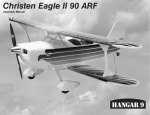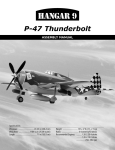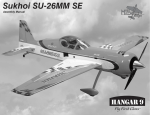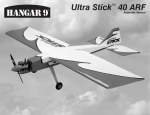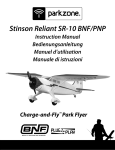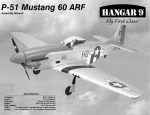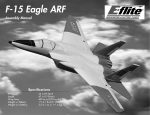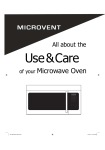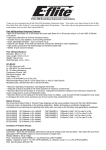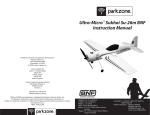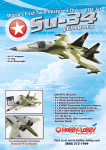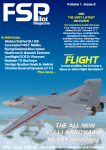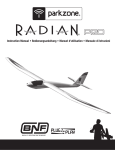Download Sukhoi SU-26m 480 ARF - E
Transcript
Sukhoi SU-26m 480 ARF Assembly Manual Specifications Wingspan: Length: Wing Area: Weight w/o Battery: Weight w/Battery: 43 in (1090mm) 39 in (990mm) 365 sq in (23.5 sq dm) 24–26 oz (680–740 g) 30–32 oz (850–910 g) Table of Contents Introduction................................................................ 2 Important Information Regarding Warranty Information............................................. 2 Using the Manual........................................................ 2 Contents of Kit/Parts Layout......................................... 2 Covering Colors.......................................................... 2 Recommended Radio Equipment.................................. 3 Optional Accessories................................................... 3 Brushless Outrunner Setup........................................... 3 Required Tools and Adhesives...................................... 3 Note on Lithium Polymer Batteries................................ 3 Warning..................................................................... 3 Landing Gear Installation............................................. 4 Optional Wheel Pants Installation................................. 5 Outrunner Motor Installation........................................ 5 Cowling Installation..................................................... 7 Aileron Hinging.......................................................... 8 Aileron Servos and Linkages........................................ 9 Wing Installation....................................................... 12 Stabilizer and Elevator.............................................. 12 Rudder and Fin......................................................... 16 Rudder and Elevator Servos....................................... 18 Final Assembly.......................................................... 21 Control Throws......................................................... 22 Center of Gravity...................................................... 22 Preflight.................................................................... 23 Range Test Your Radio............................................... 23 Flying Your Sukhoi SU-26m 480................................ 23 Safety Do’s and Don’ts for Pilots................................. 24 Safety Precautions..................................................... 24 Age Requirements..................................................... 24 Warranty Information................................................ 24 CE Compliance Information for the European Union.................................................. 26 2008 Official Academy of Model Aeronautics Safety Code............................ 26 Introduction In the world of competition aerobatic airplanes, the Russian Sukhoi SU-26m is the equivalent of a top fuel dragster that can turn on a dime. Its combination of absurd amounts of horsepower, light weight, rugged construction and amazing agility allows aggressive pilots to perform to the limits of their physical endurance. E-flite perfectly captures the essence of this aerial hot rod with its Sukhoi SU-26m – a scaled-down version of the Hangar 9 Sukhoi SU-26m designed by world-class IMAC competitor Mike McConville. The E-flite SU-26m features an exceptionally lightweight airframe that was designed around the powerful Park 480 BL outrunner motor (sold separately). As with the full-scale Sukhoi, this combination of lightweight construction and prodigious power gives the E-flite SU-26m unlimited performance that is ideally suited for 3D aerobatics. Contents of Kit/Parts Layout Replacement Parts EFL2851 Wing Set EFL2852 Fuselage w/Hatch EFL2853 Tail Set EFL2854 Wing Tube EFL2855 Landing Gear Set EFL2857 Pushrod Set EFL2858 Canopy Hatch EFL2859 Cowling EFL2860 Canopy EFL2862 Hardware Pack EFLA222Foam Park Wheels, 13/4-inch (45mm) Important Information Regarding Warranty Information Please read our Warranty and Liability Limitations section on Page 24 before building this product. If you as the Purchaser or user are not prepared to accept the liability associated with the use of this Product, you are advised to return this Product immediately in new and unused condition to the place of purchase. Using the Manual This manual is divided into sections to help make assembly easier to understand, and to provide breaks between each major section. In addition, check boxes have been placed next to each step to keep track of its completion. Steps with a single circle () are performed once, while steps with two circles ( ) indicate that the step will require repeating, such as for a right or left wing panel, two servos, etc. Covering Colors HANU973 HANU877 HANU847 Lite Scale White Orange Pearl Purple Remember to take your time and follow the directions. 2 E-flite Sukhoi SU-26m 480 ARF Assembly Manual Recommended Radio Equipment You will need a minimum of a 6-channel transmitter, receiver and four servos. You can choose to purchase a complete radio system. If you are using an existing transmitter, just purchase the other required equipment separately. We recommend the crystalfree, interference-free Spektrum™ DX6i 2.4GHz DSM® 6-channel system. If using your own transmitter, we recommend the E-flite S75 Sub-Micro servos. If you own a Spektrum radio, just add a DSM2™ receiver and four E-flite S75 Sub-Micro servos. We show the installation of the AR6200 receiver in the manual. Radio System SPM6600 DX6i DSM2 6CH system Or Purchase Separately SPMAR6200AR6200 DSM2 6-Channel Full Range Receiver (for DX5e, DX6i, or DX7) And EFLREX6L6-inch Extension, Lightweight (2) EFLREX12L12-inch Extension, Lightweight (2) Optional Accessories EFLA110 Power Meter EFLC3005Celectra™ 1- to 3-Cell Li-Po Charger EFLC505Intelligent 1- to 5-Cell Balancing Charger EFL2856 Dummy Motor EFLA152 1/9-scale Aerobatic Pilot EFL2863 Wheel Pants EFLSP17513/4-inch (45mm) Aluminum Spinner w/4mm & 5mm Collets Brushless Outrunner Setup EFLM1505Park 480 Brushless Outrunner Motor, 1020Kv APC12060E 12x6 Electric Propeller EFLA1040L40-Amp Lite Pro Switch-Mode BEC Brushless THP21003SPL22100mAh 3S 11.1V 20C Li-Po, 13AWG Required Tools and Adhesives Tools & Equipment Felt-tipped pen Hobby knife (#11 blade) Mixing sticks Nut driver: 5mm Paper towels Pin drill Ruler (EFLA264) Square String/dental floss T-pins Low tack tape Side cutters Sand paper Petroleum jelly Waxed paper Rubbing alcohol Epoxy brush Phillips screwdriver: #0, #1, #2 (EFLA257 and EFLA258) Hex wrench or ball driver: 3/32-inch (EFLA251) Drill bit: 1/16-inch (1.5mm) Warning An RC aircraft is not a toy! If misused, it can cause serious bodily harm and damage to property. Fly only in open areas, preferably at AMA (Academy of Model Aeronautics) approved flying sites, following all instructions included with your radio. Keep loose items that can get entangled in the propeller away from the prop, including loose clothing, or other objects such as pencils and screwdrivers. Especially keep your hands away from the propeller. During the course of building your Sukhoi SU-26m, we suggest that you use a soft base for the building surface. Such things as a foam stand, large piece of bedding foam or a thick bath towel will work well and help protect the model from damage during assembly. Adhesives Threadlock Canopy glue Thin CA Medium CA Tie wrap 6-Minute Epoxy (HAN8000) 30-minute epoxy (HAN8002) Note on Lithium Polymer Batteries Lithium Polymer batteries are significantly more volatile than alkaline or Ni-Cd/ Ni-MH batteries used in RC applications. All manufacturer’s instructions and warnings must be followed closely. Mishandling of Li-Po batteries can result in fire. Always follow the manufacturer’s instructions when disposing of Lithium Polymer batteries. The Spektrum trademark is used with permission of Bachmann Industries, Inc. E-flite Sukhoi SU-26m 480 ARF Assembly Manual 3 Landing Gear Installation 3. Slide a 3mm x 25mm machine screw through one of the 13/4-inch wheels. Thread a 3mm nylon lock nut on the screw as shown. Required Parts Fuselage Main landing gear (2) 13/4-inch (45mm) wheel (2) 3mm x 25mm machine screws (2) #4 washers (4) 3mm nylon lock nut (4) 4-40 x 1/2-inch socket head screw (4) Required Tools and Adhesives Phillips screwdriver: #2 Nut driver: 5mm Hex wrench: 3/32-inch Threadlock You may consider using a larger diameter wheel, such as 21/4-inch (58mm) (EFLA224), if your flying site has rough terrain. 2. Slide the landing gear in the slot in the side of the fuselage. Secure the landing gear using two 4-40 x 1/2-inch socket head screws and two #4 washers. Use threadlock on the screws before tightening them with a 3/32-inch hex wrench or ball driver. 1. Remove the hatch from the fuselage by lifting it up at the rear and sliding it back to disengage the pins at the front. 4. Attach the wheel to the landing gear using a 3mm lock nut. Use a #2 Phillips screwdriver and 5mm nut driver to tighten the nut. 4 E-flite Sukhoi SU-26m 480 ARF Assembly Manual Optional Wheel Pants Installation Make sure the wheel can rotate freely. If not, loosen the 3mm lock nut so the 3mm nut can be backed away from the wheel. Retighten the assembly and check that the wheel can rotate freely. 5. Repeat Steps 2 through 4 for the remaining wheel. Required Parts Fuselage assembly Wheel pant (left and right) (EFL2863) 2mm x 4mm wood screw (4) Required Tools and Adhesives Phillips screwdriver: #1 1. Slide the wheel pant over the wheel. Use two 2mm x 4mm sheet metal screws to secure the wheel pant to the landing gear. Use a #1 Phillips screwdriver to tighten the screws. Repeat for opposite side. Outrunner Motor Installation Required Parts Fuselage Radio system 3S Li-Po battery Plywood X-mount spacers (2) Brushless motor with mounting hardware Electronic speed control 4-40 x 5/8-inch socket head screw (4) #4 washer (4) Required Tools and Adhesives Threadlock Tie wrap Hex wrench: 3/32-inch Phillips screwdriver: #2 This section covers the installation of the recommended Park 480 Outrunner motor. The holes in the firewall match the mounting pattern of the X-mount. E-flite Sukhoi SU-26m 480 ARF Assembly Manual 1. Attach the supplied aluminum motor X-mount to the motor using the screws provided with the motor. Make sure to use threadlock on the screws before tightening them with a #2 Phillips screwdriver. 5 2. Attach the Outrunner motor to the front of the firewall using two plywood X-mount spacers, four #4 washers and four 4-40 x 5/8-inch socket head screws. Tighten the screws using a 3/32-inch ball driver or hex wrench. Important Information about Your Brushless ESC 4. Connect the leads from the ESC to the leads from the motor. Use a tie wrap (not included) to secure the motor leads so they will not interfere with the operation of the motor. 5. Connect the speed control to the radio system and motor battery. Check that the motor is rotating in the correct direction. It will rotate counterclockwise when viewed from the front of the aircraft. Use the instructions with your speed control to correct a motor that is operating in the wrong direction. Make sure your ESC brake is programmed to Off. Also, be sure to use an ESC with the proper 9V cutoff when using 3-cell Li-Po packs, or 6V cutoff when using 2-cell Li-Po packs. 6 3. Solder any connectors to the speed control to connect to the motor battery and motor if necessary. Use hook and loop tape to secure the speed control inside the fuselage as shown. Make sure to guide the leads for the motor through the fuselage. E-flite Sukhoi SU-26m 480 ARF Assembly Manual Cowling Installation Required Parts Fuselage w/motor installed 2mm x 8mm wood screw (4) Cowling Propeller Prop adapter (for outrunner motor) Dummy motor (optional) E-flite 13/4-inch aluminum spinner (optional) 2. Use thin CA to harden the holes in the hardwood cowl mounts. This will help to prevent the screws from vibrating loose in flight. 4. Slide the cowling onto the fuselage. Use a #1 Phillips screwdriver to secure the cowl using four 2mm x 8mm sheet metal screws. Required Tools and Adhesives Thin CA T-pin Phillips screwdriver: #1 Optional Tools and Adhesives 30-minute epoxy Mixing stick Epoxy brush Rubbing alcohol Paper towel 1. Use a T-pin to poke a hole through the fuselage side to locate the center of the hardwood cowl mounts inside the fuselage. If installing dummy motor 3. After painting the dummy motor, use 30-minute epoxy to glue it into the cowling as shown. Make sure to allow the epoxy to fully cure before proceeding to mount the cowl to the fuselage. Important Information about Your Propeller It is very important to check to be sure the propeller is balanced before installing onto the shaft. An unbalanced propeller may strip the gears or cause poor flight characteristics. Make sure to check the balance of the propeller after enlarging the hole in the propeller. E-flite Sukhoi SU-26m 480 ARF Assembly Manual 5. Install the propeller assembly onto the motor shaft. Tighten the propeller nut using a hex wrench slipped through the hole in the propeller nut. 7 6. An optional 13/4-inch spinner is also available for your model. It can be installed at this time. Aileron Hinging Required Parts Wing (left and right) Aileron (left and right) CA hinges (8) 2. Slide four hinges into the slits in the aileron. Center the slot in the hinge with the hole drilled in Step 1. Place a T-pin in each hinge to prevent it from being pushed into the wing when installing the aileron. Required Tools and Adhesives T-pins Thin CA Pin drill Paper towel Hobby knife with #11 blade Drill bit: 1/16-inch (1.5mm) 1. Locate the positions for the hinges. Drill a 1/16inch (1.5mm) hole in the center of each slot of both the wing and aileron. This creates a tunnel for the CA, allowing the CA to penetrate into the hinge better, bonding the hinges more securely. Do not use CA accelerator during the hinging process. The CA must be allowed to soak into the hinge to provide the best bond. Using accelerator will not provide enough time for this process. 3. Slide the aileron into position. Check to make sure it can move without interference at the wing root and wing tip. Remove the T-pins and apply Thin CA to each hinge. Make sure the hinge is fully saturated with CA. Use a paper towel to clean up any excess CA from the wing and aileron. Make sure to apply CA to both sides of the hinge. 8 E-flite Sukhoi SU-26m 480 ARF Assembly Manual 4. Firmly grasp the wing and aileron and gently pull on the aileron to ensure the hinges are secure and cannot be pulled apart. Use caution when gripping the wing and aileron to avoid crushing the structure. Placing a #11 hobby blade between the aileron leading edge and wing trailing edge to position the aileron will result in a nice free-moving hinge for 3D throws without any binding. Aileron Servos and Linkages Required Parts Radio system Wing panel (right and left) Micro control connector (2) 2mm x 4mm machine screw (2) 31/2-inch (89mm) pushrod (2) Control horn (2) Servo (2) 6-inch (150mm) servo extension (2) Required Tools and Adhesives Hobby knife Pin drill 6-minute epoxy Thin CA Side cutters Phillips screwdriver: #0, #1 Drill bit: 1/16-inch (1.5mm) String or dental floss 5. Work the aileron up and down several times to work in the hinges and check for proper movement. We suggest using the long 3D servo arms for the Sukhoi SU-26m 480. Replace all existing arms before installing the servos as shown in Step 8. 1. Attach a 6-inch (150mm) servo extension. Use string or dental floss to secure the servo lead and extension to prevent them from unplugging in flight. E-flite Sukhoi SU-26m 480 ARF Assembly Manual 6. Repeat Steps 1 through 5 for the remaining aileron. 9 2. Place the servo in the wing. Guide the servo lead out through the opening at the wing root. 3. Use a pin drill and 1/16-inch (1.5mm) drill bit to drill two holes through the servo mounting tabs into the wing. Use care not to drill through the top of the wing by accident. 10 4. Apply 2–3 drops of thin CA into each hole to harden the surrounding wood. This will make the screws more secure and less likely to vibrate loose. 5. Use a #1 Phillips to secure the aileron servo using the screws provided with the servo. 6. Use 6-minute epoxy to attach the control horn to the aileron. 7. Use a #0 Phillips screwdriver to remove the stock servo horn from the aileron servo. E-flite Sukhoi SU-26m 480 ARF Assembly Manual 8. Place a 3D servo horn on the aileron servo. 10. Use a pin drill and 1/16-inch (1.5mm) drill bit The horn should align with the hinge line when the to enlarge the outer hole of the aileron servo horn. radio is on and the aileron servo plugged into the receiver. There are an odd number of splines on the servo, so you may need to remove the horn and rotate it 180 degrees to get it to align correctly. 13. With the radio system on, make sure to center the aileron trim and stick. Make sure the aileron servo is operating properly using the transmitter. Insert the z-bend of the 31/2-inch (89mm) pushrod into the center hole of the aileron control horn. Slide the pushrod wire through the micro connector on the servo horn. Center the aileron, and secure the position of the wire using the 2mm x 4mm screw and a #1 Phillips screwdriver. 11. Attach the micro control connector to the servo horn. Be sure to use the included retainer to secure the micro control connector. 9. Use side cutters to remove the arm from the servo horn that does not align with the control horn. 12. Secure the servo horn prepared in the last few steps using the screw from the servo and a #0 Phillips screwdriver. Make sure the horn aligns with the aileron hinge line when the radio system is on and the aileron servo is centered. E-flite Sukhoi SU-26m 480 ARF Assembly Manual 14. Repeat Steps 1 through 13 for the remaining servo and linkage. 11 Wing Installation Required Parts Fuselage Wing (right and left) Wing tube #4 washer (2) 4-40 x 3/8-inch machine screw (2) 3. Secure the panels using a 4-40 x 3/8-inch machine screws and #4 washers. Use a 3/32-inch hex wrench to tighten the socket head screw. Required Tools and Adhesives Hex wrench: 3/32-inch Stabilizer and Elevator Required Parts Fuselage w/wing installed Stabilizer Elevator CA hinge (6) Micro control horn with backplate Required Tools and Adhesives Hobby knife Felt-tipped pen Ruler T-pins Thin CA Medium CA Sandpaper Paper towls Hobby knife with #11 blade 1. Slide the wing tube into one of the wing panels. 4. Repeat Steps 2 and 3 to attach the remaining wing panel to the fuselage. 1. Position the stabilizer into the slot in the aft end of the fuselage. Check that the stabilizer is centered in the fuselage. 2. Slide the wing panel with tube into position on the fuselage. Make sure to guide the aileron servo extension in the hole in the side of the fuselage. 12 E-flite Sukhoi SU-26m 480 ARF Assembly Manual 2. View the airframe from the rear and make sure the wing and stab are parallel. If not, lightly sand the stab saddle until they are. 5. Use a sharp hobby knife to cut the covering slightly inside the lines drawn. Be very careful not to cut into the underlying wood, as this will weaken the stab and cause it to fail in flight. 6. Insert the micro control horn into the slot in the elevator. Make sure the holes in the control horn face forward and that the horn is on the side with the clear covering (bottom). 7. Slide the micro control horn backplate on the control horn from the top side of the elevator. Apply 2–3 drops of medium CA at the joint between the horn and backplate to keep it secure. Adjust parallel You can use a soldering iron instead of a knife. This will eliminate the chances of cutting into the wood. 3. Measure from the stab tip to the wing tip. Adjust the stab until the measurements are equal. A A A=A 4. Double-check the adjustments from Steps 1 through 3. Use a felt-tipped pen to trace the outline of the fuselage onto the top and bottom of the stabilizer. E-flite Sukhoi SU-26m 480 ARF Assembly Manual 13 14 8. Slide the elevator into position, then the stabilizer. 9. Check the alignment and make sure everything lines up. Wick thin CA into the joint between the fuselage and stabilizer. Make sure to glue both top and bottom. Do not use accelerator—to allow the CA to wick in the joint, providing the best bond possible. 10. Slide six hinges into the slits in the elevator. Place a T-pin in each hinge to prevent it from being pushed into the elevator when attaching it to the stabilizer. Slide the elevator tight against the stabilizer. E-flite Sukhoi SU-26m 480 ARF Assembly Manual Placing a #11 hobby blade between the elevator and stabilizer to position the two will result in a nice freemoving hinge for 3D throws without any binding. E-flite Sukhoi SU-26m 480 ARF Assembly Manual 13. Work the elevator up and down several times to work in the hinges and check for proper movement. Do not use CA accelerator during the hinging process. The CA must be allowed to soak into the hinge to provide the best bond. Using accelerator will not provide enough time for this process. 11. Remove the T-pins and apply thin CA to each hinge. Make sure the hinge is fully saturated with CA. Use a paper towel to clean up any excess CA from the elevator and stabilizer. Make sure to apply CA to both sides of the hinge. 12. Firmly grasp the stabilizer and gently pull on the elevator to ensure the hinges are secure and cannot be pulled apart. Use caution when gripping the elevator and stabilizer to avoid crushing the structure. 15 Rudder and Fin 2. Apply a small amount of petroleum jelly to the top and bottom of the tail wheel bushing. Work the jelly into the bushing to prevent the CA from seeping in between them and gluing them together. 3. Use 6-minute epoxy to glue the wire into the hole in the bottom of the rudder. Take care not to get epoxy on the bushing that could accidentally glue it to the rudder. Required Parts Fuselage Rudder Fin CA hinge (3) Micro control horn with backplate Tail wheel assembly 4. Slide the tail wheel onto the wire. The wheel is then secured using the tail wheel keeper and a drop of thin CA. 5. Slide three hinges into the slits in the rudder. Place a T-pin in each hinge to prevent it from being pushed into the rudder when attaching it to the fin. Required Tools and Adhesives Hobby knife Thin CA Felt-tipped pen Square 6-minute epoxy Petroleum jelly T-pins Sandpaper 16 1. Use a hobby knife and #11 blade to remove the covering and expose the slot in the bottom of the rudder for the tail wheel assembly. E-flite Sukhoi SU-26m 480 ARF Assembly Manual 6. Slide the rudder tight against the fin. Make sure to guide the tail wheel bearing into the slot at the bottom of the fin. Placing a #11 hobby blade between the elevator and stabilizer to position the two will result in a nice freemoving hinge for 3D throws without any binding. 8. Firmly grasp the rudder and gently pull on the fin to ensure the hinges are secure and cannot be pulled apart. Use caution when gripping the rudder and fin to avoid crushing the structure. 10. Place the fin in position on the fuselage. Trace the outline of the fuselage onto both sides of the fin using a felt-tipped pen. 9. Work the rudder up and down several times to work in the hinges and check for proper movement. 11. Use a hobby knife with a #11 blade to remove the covering from the bottom of the fin using the same technique used for the stabilizer. 7. Remove the T-pins and apply thin CA to each hinge. Make sure the hinge is fully saturated with CA. Use a paper towel to clean up any excess CA from the rudder and fin. Make sure to apply CA to both sides of the hinge. E-flite Sukhoi SU-26m 480 ARF Assembly Manual 17 12. Position the fin back onto the fuselage. Use a square to check the alignment between the fin and stabilizer. Lightly sand the bottom of the fin until the alignment is correct. Use thin CA to glue the fin to the fuselage. Also apply CA to the rudder post at the back edge of the fuselage. 13. Insert the micro control horn into the slot in the rudder. Make sure the holes in the control horn face forward and that the horn is on the side opposite the elevator control horn. Rudder and Elevator Servos Required Parts Fuselage 41/2-inch (115mm) pushrod wire (2) Micro control connector w/retainer (2) Radio system Receiver Hook and loop tape Servo (2) 3D servo horn (2) 12-inch (305mm) servo extension (2) Required Tools and Adhesives Side cutters Phillips screwdriver: #0 Pin drill Thin CA Drill bit: 1/16-inch (1.5mm) 18 14. Slide the micro control horn backplate on the control horn from the opposide side of the rudder as the control horn. Apply 2–3 drops of thin CA at the joint between the horn and backplate to keep it secure. 1. Secure a 12-inch (305mm) servo extension to the servo. E-flite Sukhoi SU-26m 480 ARF Assembly Manual 2. Use a pin drill and 1/16-inch (1.5mm) drill bit to drill holes through the servo mounting tabs and into the fuselage. 4. Use a #0 Phillips screwdriver and the screws provided with the servo to secure the elevator servo in the fuselage. 3. Apply 2–3 drops of thin CA into each of the two holes to harden the surrounding wood. 5. Use side cutters to remove one of the arms from a 3D servo horn. Use a pin drill and 1/16-inch (1.5mm) drill bit to enlarge the outer hole of the servo horn. 6. Attach the micro control connector to the servo horn. Be sure to use the included retainer to secure the micro control connector. 7. Center the elevator servo. Use a #0 Phillips screwdriver to remove the stock servo horn and install the horn prepared in the previous steps. E-flite Sukhoi SU-26m 480 ARF Assembly Manual 19 8. Insert the bend in the 41/2-inch (115mm) pushrod wire into the middle hole of the elevator control horn. 14. Repeat Steps 1 though 13 to install the rudder servo and linkage. The linkage will also connect to the center hole of the rudder control horn and to the outside hole of the 3D servo horn. 15. Use hook and loop tape to mount the receiver and remote receiver in the fuselage. Plug the elevator, rudder and speed control leads into the appropriate ports of the receiver. 13. With the radio system on, make sure to center the elevator trim and stick. Make sure the elevator servo is operating properly using the transmitter. Slide the pushrod wire through the micro connector on the servo horn. Center the elevator, and secure the position of the wire using the 2mm x 4mm screw and a #0 Phillips screwdriver. 20 E-flite Sukhoi SU-26m 480 ARF Assembly Manual Final Assembly 2. Use medium CA to glue the pilot (optional) to the canopy hatch as shown. 3. Place the canopy hatch on the fuselage. Make sure to place a piece of waxed paper or part of a bag from the packaging of your model between the hatch and fuselage so when the canopy is glued to the hatch it won’t accidentally be glued to the fuselage. Make sure that the hatch is fully seated on the fuselage, and the magnet in engaged during this step. If it is not seated and engaged, it could cause your hatch to fit improperly or not engage once the canopy is glued on. 4. Use canopy glue to secure the canopy to the hatch. Use low-tack tape to keep the canopy in opposition on the fuselage until the glue fully cures. Required Parts Fuselage Canopy Battery Battery hatch Hook and loop tape Hook and loop strap Pilot (optional) Required Tools and Adhesives Canopy glue Low tack tape Medium CA Waxed paper 1. With the aircraft fully assembled, install the battery into the battery compartment. Secure the battery using the hook and loop tape and the hook and loop straps. Place a piece of hook and loop tape on the bottom of the battery and on the fuselage where the battery rests. This will keep the battery from shifting forward or backward during extreme maneuvers. E-flite Sukhoi SU-26m 480 ARF Assembly Manual 21 Control Throws 1. Turn on the transmitter and receiver of your Sukhoi SU-26m. Check the movement of the rudder using the transmitter. When the stick is moved right, the rudder should also move right. Reverse the direction of the servo at the transmitter if necessary. 2. Check the movement of the elevator with the radio system. Moving the elevator stick toward the bottom of the transmitter will make the airplane elevator move up. 3. Check the movement of the ailerons with the radio system. Moving the aileron stick right will make the right aileron move up and the left aileron move down. 4. Use a ruler to adjust the throw of the elevator, ailerons and rudder. Adjust the position of the pushrod at the control horn to achieve the following measurements when moving the sticks to their endpoints. Aileron Low Rate Up 3/4-inch Down 3/4-inch (19mm) (19mm) Aileron High Rate Up 11/4-inch Down 11/4-inch (32mm) (32mm) Elevator Low Rate Up 1-inch Down 1-inch (25mm) (25mm) Elevator High Rate Up 2-inch Down 2-inch (50mm) (50mm) Rudder Low Rate Up 11/2-inch Down 11/2-inch Rudder High Rate Up 2-inch Down 2-inch (38mm) (38mm) (50mm) (50mm) Center of Gravity An important part of preparing the aircraft for flight is properly balancing the model. Caution: Do not inadvertently skip this step! The recommended Center of Gravity (CG) location for your model is 31/2 to 37/8 inches (89 to 98mm) back from the leading edge of the wing. Mark the location for the Center of Gravity on the top of the wing next to the fuselage as shown. When balancing your model, support the plane inverted at the marks made on the top of the wing with your fingers or a commercially available balancing stand. Adjust components as necessary so the model hangs level or slightly nose down. This is the correct balance point for your model. You might find you may be required to add a small amount of weight to either the front or back of the fuselage to achieve the correct balance. Measurements are taken at the inner or widest point on the control surface. These are general guidelines measured from our own flight tests. You can experiment with higher rates to match your preferred style of flying. Travel Adjust, Sub Trim and Dual Rates are not listed and should be adjusted according to each individual model and preference. 22 After the first flights, the CG position can be adjusted for your personal preference. E-flite Sukhoi SU-26m 480 ARF Assembly Manual Preflight Check Your Radio Before going to the field, be sure that your batteries are fully charged per the instructions included with your radio. Charge both the transmitter and receiver pack for your airplane. Use the recommended charger supplied with your particular radio system, following the instructions provided with the radio. In most cases, the radio should be charged the night before going out flying. Range Test Your Radio Before each flying session, be sure to range check your radio. See your radio manual for the recommended range and instructions for your radio system. Each radio manufacturer specifies different procedures for their radio systems. Next, start the motor. With the model securely anchored, check the range again. The range test should not be significantly affected. If it is, don’t attempt to fly! Have your radio equipment checked out by the manufacturer. Keep loose items that can get entangled in the propeller away from the prop. These include loose clothing, or other objects such as pencils and screwdrivers. Especially keep your hands away from the propeller. Double-check that all controls (aileron, elevator, rudder and throttle) move in the correct direction. Check the radio installation and make sure all the control surfaces are moving correctly (i.e. the correct direction and with the recommended throws). Test run the motor and make sure it transitions smoothly from off to full throttle and back. Also ensure the engine is installed according to the manufacturer’s instructions, and it will operate consistently. 1. Before each flying session, be sure to range check your radio. This is accomplished by turning on your transmitter with the antenna collapsed. Turn on the receiver in your airplane. With your airplane on the ground and the engine running, you should be able to walk 30 paces (approximately 100 feet) away from your airplane and still have complete control of all functions. If not, don’t attempt to fly! Have your radio equipment checked out by the manufacturer. 2. Double-check that all controls (aileron, elevator, rudder and throttle) move in the correct direction. 3. Be sure that your transmitter batteries are fully charged, per the instructions included with your radio. Flying Your Sukhoi SU-26m 480 Flying the Sukhoi SU-26m 480 is about as fun as it can get at the park. A very light wing loading and extreme control throws make for some exciting 3D flying. Verify that your CG is at the correct location as per the manual and that you have your rates set up to your liking. Verify all control throws are in the correct direction and the motor spins in the correct direction as well. Point the model into the wind and add some throttle trim until the motor begins to turn. This will be your flight idle. Now, apply power slowly. You will find the model will become airborne very quickly and at a low speed. This model excels at flying slow and easy as well as fast and extreme. Trim the model for level flight at half throttle. Only use full throttle for maneuvering. It is not recommended to fly this model fast or at full throttle in level flight. Doing this can result in the flight controls fluttering and a potential catastrophic failure of the airframe. You will find you can adjust the CG to your liking by moving the battery pack fore or aft on the fuselage. Also keep the battery on the fuselage mounted high (at least at wing centerline or above) to help in hovering maneuvers and harriers. To land the Sukhoi SU-26m 480, just reduce the throttle to idle and feed in up elevator until the model settles into a slightly nose high attitude. Gently fly the model down to the landing spot with a final flair at touchdown. You will find the model will have a very short roll out. We hope you enjoy the Sukhoi SU-26m 480 as much as we do. Happy landings. Check all the control horns, servo horns, and clevises to make sure they are secure and in good condition. Replace any items that would be considered questionable. Failure of any of these components in flight would mean the loss of your aircraft. E-flite Sukhoi SU-26m 480 ARF Assembly Manual 23 Safety Do’s and Don’ts for Pilots • Check all control surfaces prior to each takeoff. •D o not fly your model near spectators, parking areas or any other area that could result in injury to people or damage of property. •D o not fly during adverse weather conditions. Poor visibility can cause disorientation and loss of control of your aircraft. Strong winds can cause similar problems. •D o not take chances. If at any time during flight you observe any erratic or abnormal operation, land immediately and do not resume flight until the cause of the problem has been ascertained and corrected. Safety can never be taken lightly. • Do not fly near power lines. Age Requirements Age Recommendation: 14 years or over. This is not a toy. This product is not intended for use by children without direct adult supervision. Safety, Precautions and Warnings As the user of this product, you are solely responsible for operating it in a manner that does not endanger yourself and others or result in damage to the product or the property of others. Carefully follow the directions and warnings for this and any optional support equipment (chargers, rechargeable battery packs, etc.) that you use. This model is controlled by a radio signal that is subject to interference from many sources outside your control. This interference can cause momentary loss of control so it is necessary to always keep a safe distance in all directions around your model, as this margin will help to avoid collisions or injury. •A lways operate your model in an open area away from cars, traffic or people. •A void operating your model in the street where injury or damage can occur. •N ever operate the model out into the street or populated areas for any reason. •N ever operate your model with low transmitter batteries. •C arefully follow the directions and warnings for this and any optional support equipment (chargers, rechargeable battery packs, etc.) that you use. •K eep all chemicals, small parts and anything electrical out of the reach of children. •M oisture causes damage to electronics. Avoid water exposure to all equipment not specifically designed and protected for this purpose. 24 Warranty Information Warranty Period Exclusive Warranty- Horizon Hobby, Inc., (Horizon) warranties that the Products purchased (the “Product”) will be free from defects in materials and workmanship at the date of purchase by the Purchaser. Limited Warranty (a) This warranty is limited to the original Purchaser (“Purchaser”) and is not transferable. REPAIR OR REPLACEMENT AS PROVIDED UNDER THIS WARRANTY IS THE EXCLUSIVE REMEDY OF THE PURCHASER. This warranty covers only those Products purchased from an authorized Horizon dealer. Third party transactions are not covered by this warranty. Proof of purchase is required for warranty claims. Further, Horizon reserves the right to change or modify this warranty without notice and disclaims all other warranties, express or implied. (b) Limitations- HORIZON MAKES NO WARRANTY OR REPRESENTATION, EXPRESS OR IMPLIED, ABOUT NON-INFRINGEMENT, MERCHANTABILITY OR FITNESS FOR A PARTICULAR PURPOSE OF THE PRODUCT. THE PURCHASER ACKNOWLEDGES THAT THEY ALONE HAVE DETERMINED THAT THE PRODUCT WILL SUITABLY MEET THE REQUIREMENTS OF THE PURCHASER’S INTENDED USE. (c) Purchaser Remedy- Horizon’s sole obligation hereunder shall be that Horizon will, at its option, (i) repair or (ii) replace, any Product determined by Horizon to be defective. In the event of a defect, these are the Purchaser’s exclusive remedies. Horizon reserves the right to inspect any and all equipment involved in a warranty claim. Repair or replacement decisions are at the sole discretion of Horizon. This warranty does not cover cosmetic damage or damage due to acts of God, accident, misuse, abuse, negligence, commercial use, or modification of or to any part of the Product. This warranty does not cover damage due to improper installation, operation, maintenance, or attempted repair by anyone other than Horizon. Return of any goods by Purchaser must be approved in writing by Horizon before shipment. E-flite Sukhoi SU-26m 480 ARF Assembly Manual Damage Limits HORIZON SHALL NOT BE LIABLE FOR SPECIAL, INDIRECT OR CONSEQUENTIAL DAMAGES, LOSS OF PROFITS OR PRODUCTION OR COMMERCIAL LOSS IN ANY WAY CONNECTED WITH THE PRODUCT, WHETHER SUCH CLAIM IS BASED IN CONTRACT, WARRANTY, NEGLIGENCE, OR STRICT LIABILITY. Further, in no event shall the liability of Horizon exceed the individual price of the Product on which liability is asserted. As Horizon has no control over use, setup, final assembly, modification or misuse, no liability shall be assumed nor accepted for any resulting damage or injury. By the act of use, setup or assembly, the user accepts all resulting liability. If you as the Purchaser or user are not prepared to accept the liability associated with the use of this Product, you are advised to return this Product immediately in new and unused condition to the place of purchase. Law: These Terms are governed by Illinois law (without regard to conflict of law principals). Safety Precautions This is a sophisticated hobby Product and not a toy. It must be operated with caution and common sense and requires some basic mechanical ability. Failure to operate this Product in a safe and responsible manner could result in injury or damage to the Product or other property. This Product is not intended for use by children without direct adult supervision. The Product manual contains instructions for safety, operation and maintenance. It is essential to read and follow all the instructions and warnings in the manual, prior to assembly, setup or use, in order to operate correctly and avoid damage or injury. Questions, Assistance, and Repairs Your local hobby store and/or place of purchase cannot provide warranty support or repair. Once assembly, setup or use of the Product has been started, you must contact Horizon directly. This will enable Horizon to better answer your questions and service you in the event that you may need any assistance. For questions or assistance, please direct your email to [email protected], or call 877.504.0233 toll free to speak to a service technician. Inspection or Repairs If this Product needs to be inspected or repaired, please call for a Return Merchandise Authorization (RMA). Pack the Product securely using a shipping carton. Please note that original boxes may be included, but are not designed to withstand the rigors of shipping without additional protection. Ship via a carrier that provides tracking and insurance for lost or damaged parcels, as Horizon is not responsible for merchandise until it arrives and is accepted at our facility. A Service Repair Request is available at www. horizonhobby.com on the “Support” tab. If you do not have internet access, please include a letter with your complete name, street address, email address and phone number where you can be reached during business days, your RMA number, a list of the included items, method of payment for any non-warranty expenses and a brief summary of the problem. Your original sales receipt must also be included for warranty consideration. Be sure your name, address, and RMA number are clearly written on the outside of the shipping carton. Warranty Inspection and Repairs To receive warranty service, you must include your original sales receipt verifying the proof-of-purchase date. Provided warranty conditions have been met, your Product will be repaired or replaced free of charge. Repair or replacement decisions are at the sole discretion of Horizon Hobby. E-flite Sukhoi SU-26m 480 ARF Assembly Manual Non-Warranty Repairs Should your repair not be covered by warranty the repair will be completed and payment will be required without notification or estimate of the expense unless the expense exceeds 50% of the retail purchase cost. By submitting the item for repair you are agreeing to payment of the repair without notification. Repair estimates are available upon request. You must include this request with your repair. Non-warranty repair estimates will be billed a minimum of 1/2 hour of labor. In addition you will be billed for return freight. Please advise us of your preferred method of payment. Horizon accepts money orders and cashiers checks, as well as Visa, MasterCard, American Express, and Discover cards. If you choose to pay by credit card, please include your credit card number and expiration date. Any repair left unpaid or unclaimed after 90 days will be considered abandoned and will be disposed of accordingly. Please note: non-warranty repair is only available on electronics and model engines. United States: Electronics and engines requiring inspection or repair should be shipped to the following address: Horizon Service Center 4105 Fieldstone Road Champaign, Illinois 61822 All other Products requiring warranty inspection or repair should be shipped to the following address: Horizon Product Support 4105 Fieldstone Road Champaign, Illinois 61822 Please call 877-504-0233 or e-mail us at [email protected] with any questions or concerns regarding this product or warranty. 25 United Kingdom: Electronics and engines requiring inspection or repair should be shipped to the following address: Horizon Hobby UK Units 1-4 Ployters Rd Staple Tye Harlow, Essex CM18 7NS United Kingdom Please call +44 (0) 1279 641 097 or e-mail us at [email protected] with any questions or concerns regarding this product or warranty. Germany: Electronics and engines requiring inspection or repair should be shipped to the following address: Horizon Technischer Service Hamburger Strasse 10 25335 Elmshorn Germany Please call +49 4121 46199 66 or e-mail us at [email protected] with any questions or concerns regarding this product or warranty CE Compliance Information for the European Union Instructions for Disposal of WEEE by Users in the European Union This product must not be disposed of with other waste. Instead, it is the user’s responsibility to dispose of their waste equipment by handing it over to a designated collection point for the recycling of waste electrical and electronic equipment. The separate collection and recycling of your waste equipment at the time of disposal will help to conserve natural resources and ensure that it is recycled in a manner that protects human health and the environment. For more information about where you can drop off your waste equipment for recycling, please contact your local city office, your household waste disposal service or where you purchased the product. 2009 Official Academy of Model Aeronautics Safety Code GENERAL 1. A model aircraft shall be defined as a non-humancarrying device capable of sustained flight in the atmosphere. It shall not exceed limitations established in this code and is intended to be used exclusively for recreational or competition activity. 2. T he maximum takeoff weight of a model aircraft, including fuel, is 55 pounds, except for those flown under the AMA Experimental Aircraft Rules. 3. I will abide by this Safety Code and all rules established for the flying site I use. I will not willfully fly my model aircraft in a reckless and/or dangerous manner. 4. I will not fly my model aircraft in sanctioned events, air shows, or model demonstrations until it has been proven airworthy. 5. I will not fly my model aircraft higher than approximately 400 feet above ground level, when within three (3) miles of an airport without notifying the airport operator. I will yield the right-of-way and avoid flying in the proximity of full-scale aircraft, utilizing a spotter when appropriate. 6. I will not fly my model aircraft unless it is identified with my name and address, or AMA number, inside or affixed to the outside of the model aircraft. This does not apply to model aircraft flown indoors. 7. I will not operate model aircraft with metal-blade propellers or with gaseous boosts (other than air), nor will I operate model aircraft with fuels containing tetranitromethane or hydrazine. 26 E-flite Sukhoi SU-26m 480 ARF Assembly Manual 8. I will not operate model aircraft carrying pyrotechnic devices which explode burn, or propel a projectile of any kind. Exceptions include Free Flight fuses or devices that burn producing smoke and are securely attached to the model aircraft during flight. Rocket motors up to a G-series size may be used, provided they remain firmly attached to the model aircraft during flight. Model rockets may be flown in accordance with the National Model Rocketry Safety Code; however, they may not be launched from model aircraft. Officially designated AMA Air Show Teams (AST) are authorized to use devices and practices as defined within the Air Show Advisory Committee Document. 9. I will not operate my model aircraft while under the influence of alcohol or within eight (8) hours of having consumed alcohol. 10. I will not operate my model aircraft while using any drug which could adversely affect my ability to safely control my model aircraft. 11. C hildren under six (6) years old are only allowed on a flightline or in a flight area as a pilot or while under flight instruction. 12. W hen and where required by rule, helmets must be properly worn and fastened. They must be OSHA, DOT, ANSI, SNELL or NOCSAE approved or comply with comparable standards. 4. A t all flying sites a line must be established, in front of which all flying takes place. Only personnel associated with flying the model aircraft are allowed at or in front of the line. In the case of airshows demonstrations straight line must be established. An area away from the line must be maintained for spectators. Intentional flying behind the line is prohibited. 10. T he operator of a radio-controlled model aircraft shall control it during the entire flight, maintaining visual contact without enhancement other than by corrective lenses that are prescribed for the pilot. No model aircraft shall be equipped with devices which allow it to be flown to a selected location which is beyond the visual range of the pilot. 5. I will operate my model aircraft using only radiocontrol frequencies currently allowed by the Federal Communications Commission (FCC). Only individuals properly licensed by the FCC are authorized to operate equipment on Amateur Band frequencies. Sukhoi SU-26m Safe Operating Recommendations 6. I will not knowingly operate my model aircraft within three (3) miles of any preexisting flying site without a frequency-management agreement. A frequency management agreement may be an allocation of frequencies for each site, a dayuse agreement between sites, or testing which determines that no interference exists. A frequencymanagement agreement may exist between two or more AMA chartered clubs, AMA clubs and individual AMA members, or individual AMA members. Frequency-management agreements, including an interference test report if the agreement indicates no interference exists, will be signed by all parties and copies provided to AMA Headquarters. 1. A ll model flying shall be conducted in a manner to avoid over flight of unprotected people. 7. W ith the exception of events flown under official AMA rules, no powered model may be flown outdoors closer than 25 feet to any individual, except for the pilot and located at the flightline. 2. I will have completed a successful radio equipment ground-range check before the first flight of a new or repaired model aircraft. 8. U nder no circumstances may a pilot or other person touch a model aircraft in flight while it is still under power, except to divert it from striking an individual. 3. I will not fly my model aircraft in the presence of spectators until I become a proficient flier, unless I am assisted by an experienced pilot. 9. R adio-controlled night flying is limited to lowperformance model aircraft (less than 100 mph). The model aircraft must be equipped with a lighting system which clearly defines the aircraft’s attitude and direction at all times. RADIO CONTROL E-flite Sukhoi SU-26m 480 ARF Assembly Manual - Inspect your model before every flight to make certain it is airworthy. -B e aware of any other radio frequency user who may present an interference problem. -A lways be courteous and respectful of other users of your selected flight area. -C hoose an area clear of obstacles and large enough to safely accommodate your flying activity. -M ake certain this area is clear of friends and spectators prior to launching your aircraft. -B e aware of other activities in the vicinity of your flight path that could cause potential conflict. - Carefully plan your flight path prior to launch. -A bide by any and all established AMA National Model Aircraft Safety Code. 27 © 2009 Horizon Hobby, Inc. 4105 Fieldstone Road Champaign, Illinois 61822 USA (877) 504-0233 horizonhobby.com E-fliteRC.com Printed 05-09 15578




























